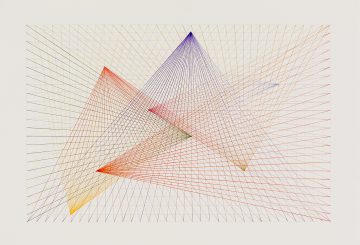Speaking of high school, as we were above, one of the threats the teachers used against us was that we’d be sent to Clown School if we misbehaved. But we wanted to go to Clown School – it was where all the kids had fun, dressing up in floppy shoes with makeup and all that, mucking about with rubber chickens and bad drama “trust” exercises.
That was before we got to know about things like (cue ominous music) “the other” and “abjection”. Suddenly funny clowns were creepy symbols of degraded humanity that are OK to laugh at, and the more we think of clowns, the more creeped out we get. It’s easy to forget that some people have good memories of clowns and circuses because it seems so foreign to us. A grown man driving a little car? Shudder.
Your reaction to Sophie Coombs’ show at Yuill/Crowley until August 7 will be entirely based on your feelings about clowns, pro or con. Called Clowns, it features clowns, real and imaginary, metaphorical clowns and general clown symbology, an examination of clowning, red noses, floppy shoes and seltzer sprays. In short, Coombs has been to Clown University where she majored in Clown Studies.
We were told that Coombs has fond memories of clowns, although the show is decidedly neutral. A work like Gold Bohemia – a collection of beer, wine and whisky bottles of various sizes crowded into a corner of the gallery – works on multiple levels. There’s the pun of the title (a brand of beer) referring to the home of beer (the Czech Republic) which is also home to famous circus troupes. We have known a few Czech people over the years and it’s fair to say they were piss heads. Is this work talking about the famous image of the clown as alcoholic (see the great work on this theme, Shakes The Clown ‘the Citizen Kane of alcoholic clown movies!’) or is it reference to the origin of absurdist theatre?
Then there are works which expand the clown theme into other realms. There is a Homer Simpson doll that has been chewed by a dog and buried, then exhumed by the artist and put in a box and called Dog’s Breakfast. A photograph of a bloke next to a barbeque is called Bangers & Hash and he’s wearing a goofy apron that’s casual looking but also washed out, the barbeque apparently located somewhere on waste ground. Then there are pictures of European clowns crudely photomontaged over a shot of Australian bush land and in the middle of the gallery is an ornate swing with a mask one might see worn to a masque ball or perhaps on an extra in Eyes Wide Shut.
Coombs has also constructed an array of collages, pictures torn from magazines ranging from acrobats and jugglers, rope acts to circuses and the Pink Panther stuck to bits of plywood and timber. Oh, and there’s a photo of a zebra painted on a wall.
The unaccountable thing about this varied collection of objects – beer bottles to photographs – is that it all adds up to a narrative about how far these images go through western society. As much as we hate to think about clowns, as soon as someone points them out to you they are absolutely everywhere – on greeting cards, on posters, bad paintings, t-shirts, in movies – they are the marginalised under class that haunt us. Perhaps Coombs thinks this is a good thing to point this out, we’re not sure, and the aesthetic of the works is rough and ready, fine edges are eschewed in favour of a frayed crumple, so you think maybe she’s saying it isn’t a good thing. We had to fight back a real sense of unease in Clowns and even if we’re not one hundred percent sure what the hell the show is all about, we like it.

